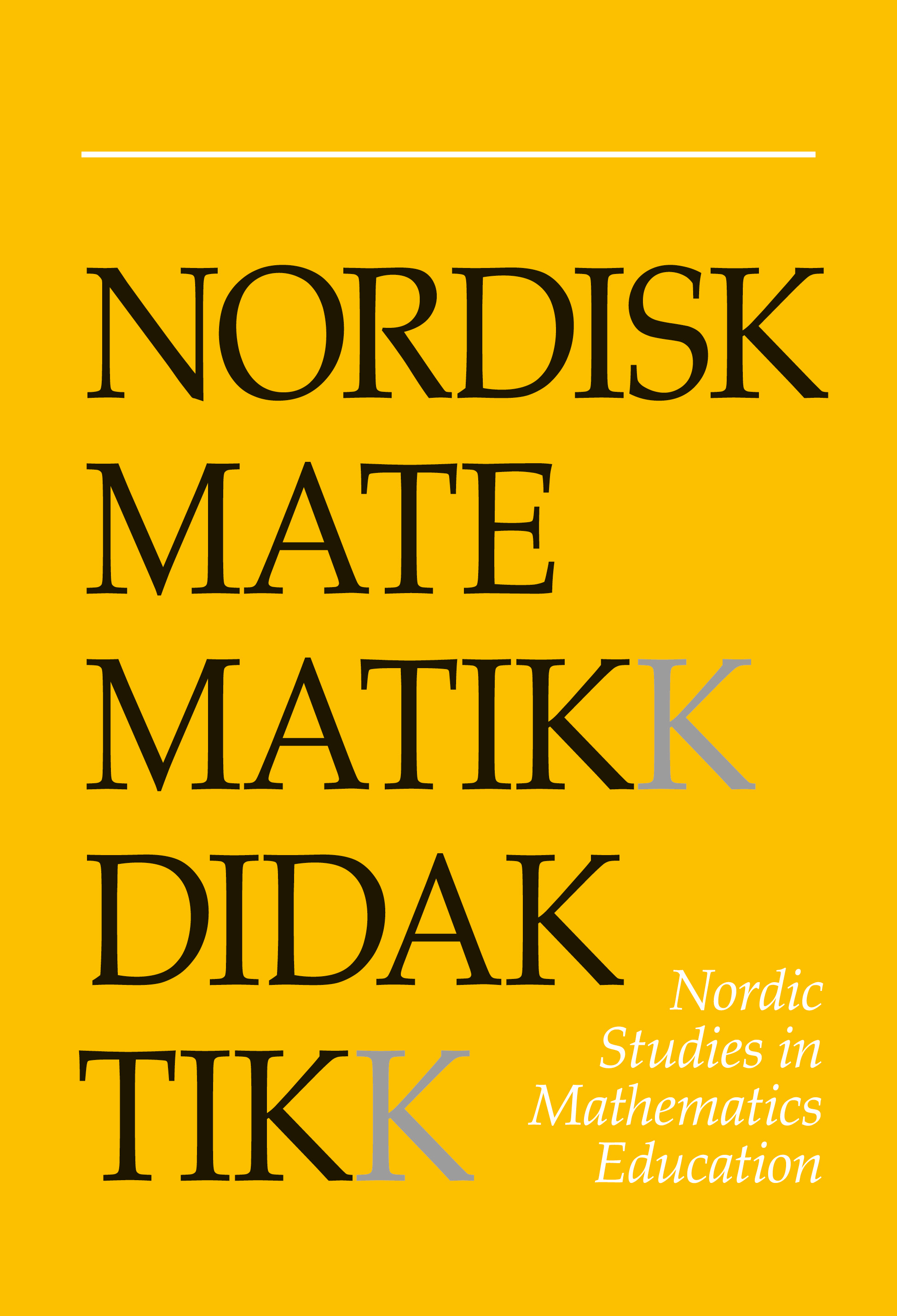Students’ reasoned dialogs during problem solving in a Norwegian thinking classroom
DOI:
https://doi.org/10.7146/nomad.v28i1-2.149255Abstract
This study explores students’ collective mathematical problem-solving processes. Grade-seven Norwegian students were observed during regular problem-solving sessions to discover how reasoned dialogs might develop in a thinking-classroom context. An analytical framework associated with sociocultural discourse analysis was used to identify utterances (dialog moves) that were essential in revealing a dynamic and continuous scaffolding process with symmetrical interaction between the students, and where the vertical whiteboards supported students during the reasoned dialogs. The context of a thinking classroom created an environment suitable for highly interactive learning where students constructed and refined their ideas in collaboration with each other. The findings also point to the crucial role of the teacher as a facilitator of classroom dialogs to get students to dig deeper into the ideas of others.
References
Bakker, A., Smit, J. & Wegerif, R. (2015). Scaffolding and dialogic teaching in mathematics education: introduction and review. ZDM, 47 (7), 1047-1065. https://doi.org/10.1007/s11858-015-0738-8
Clancey, W. J. (2008). Scientific antecedents of situated cognition. In P. Robbins & M. Aydede (Eds.), The Cambridge handbook of situated cognition (pp. 11-34). Cambridge University Press. https://doi.org/10.1017/CBO9780511816826.002
Creswell, J. W. & Poth, C. N. (2018). Qualitative inquiry and research design: choosing among five traditions. Sage Publications.
Cui, R. & Teo, P. (2021). Dialogic education for classroom teaching: a critical review. Language and Education, 35 (3), 187-203. https://doi.org/10.1080/09500782.2020.1837859
Dudley, P. (2013). Teacher learning in lesson study: what interaction-level discourse analysis revealed about how teachers utilised imagination, tacit knowledge of teaching and fresh evidence of pupils learning, to develop practice knowledge and so enhance their pupils' learning. Teaching & Teacher Education, 34, 107-121. https://doi.org/10.1016/j.tate.2013.04.006
Fauskanger, J. & Bjuland, R. (2021). Opportunities to learn ambitious mathematics teaching from co-planning instruction. Nordic Studies in Mathematics Education, 26 (3-4), 53-70.
Fernández, M., Wegerif, R., Mercer, N. & Rojas-Drummond, S. (2001). Re-conceptualizing "scaffolding" and the zone of proximal development in the context of symmetrical collaborative learning. The Journal of Classroom Interaction, 36 (2), 40-54.
Liljedahl, P. (2016). Building thinking classrooms: conditions for problem-solving. In P. Felmer, J. Kilpatrick & E. Pekhonen (Eds.), Posing and solving mathematical problems: advances and new perspectives (pp. 361-386). Springer. https://doi.org/10.1007/978-3-319-28023-3_21
Liljedahl, P. (2021). Building thinking classrooms in mathematics, grades K-12: 14 teaching practices for enhancing learning. Corwin.
Liljedahl, P. & Cai, J. (2021). Empirical research on problem solving and problem posing: a look at the state of the art. ZDM, 53 (4), 723-735. https://doi.org/10.1007/s11858-021-01291-w
Liljedahl, P., Santos-Trigo, M., Malaspina, U. & Bruder, R. (2016). Problem solving in mathematics education. In G. Kaiser (Ed.), Problem solving in mathematics education. ICME-13 topical surveys (pp. 1-39). Springer Open. https://doi.org/10.1007/978-3-319-40730-2
Littleton, K. & Mercer, N. (2013). Interthinking: putting talk to work. Routledge. https://doi.org/10.4324/9780203809433
Megowan-Romanowicz, C. (2016). Whiteboarding: a tool for moving classroom discourse from answer-making to sense-making. The Physics Teacher, 54 (2), 83-86. https://doi.org/10.1119/1.4940170
Mercer, N., Hennessy, S. & Warwick, P. (2019). Dialogue, thinking together and digital technology in the classroom: some educational implications of a continuing line of inquiry. International Journal of Educational Research, 97, 187-199. https://doi.org/10.1119/1.4940170
Michaels, S. & O'Connor, C. (2015). Conceptualizing talk moves as tools: professional development approaches for academically productive discussion. In C. Asterhan, S. Clarke & L. Resnick (Eds.), Socializing intelligence through talk and dialogue (pp. 347-362). Casemate Group. https://doi.org/10.3102/978-0-935302-43-1_27
Pruner, M. & Liljedahl, P. (2021). Collaborative problem solving in a choice-affluent environment. ZDM, 53, 753-770. https://doi.org/10.1007/s11858-021-01232-7
Säljö R. (1995). Mental and physical artifacts in cognitive practices. In P. Reimann & H. Spada (Eds.), Learning in humans and machines: towards an interdisciplinary learning science (pp. 83-96). Pergamon.
Stake, R. E. (1995). The art of case study research. Sage Publications.
Valbekmo, I. & Svorkmo, A.G. (2021). Whiteboards as a problem-solving tool. In G.A. Nortvedt, N.F. Buchholtz, J. Fauskanger, F. Hreinsdóttir, M. Hähkioniemi et al. (Eds.), Bringing Nordic mathematics education into the future. Preceedings of Norma 20. The ninth Nordic conference on mathematics education (pp. 281-288). Swedish Society for Research in Mathematics Education.
Vygotsky, L. S. (1978). Mind in society: the development of higher psychological processes. Harvard University Press.
Warwick, P., Vrikki, M., Vermunt, J. D., Mercer, N. & Halem, N. van (2016). Connecting observations of student and teacher learning: an examination of dialogic processes in Lesson study discussions in mathematics. ZDM, 48 (4), 555-569. https://doi.org/10.1007/s11858-015-0750-z
Webb, N. M., Franke, M. L., Johnson, N. C., Ing, M. & Zimmerman, J. (2021). Learning through explaining and engaging with others' mathematical ideas. Mathematical Thinking and Learning, 1-27. https://doi.org/10.1080/10986065.2021.1990744
Wegerif, R. & Mercer, N. (2000). Language for thinking: a study of children solving reasoning test problems together. In H. Cowie & D. van der Aalsvoort (Eds.), Social interaction in learning and instruction (pp. 179-192). Pergamon.
Wood, D., Bruner, J. S. & Ross, G. (1976). The role of tutoring in problem solving. Journal of Child Psychology and Psychiatry, 17 (2), 89-100. https://doi.org/10.1111/j.1469-7610.1976.tb00381.x
Downloads
Published
How to Cite
Issue
Section
License

This work is licensed under a Creative Commons Attribution-NonCommercial-ShareAlike 4.0 International License.



